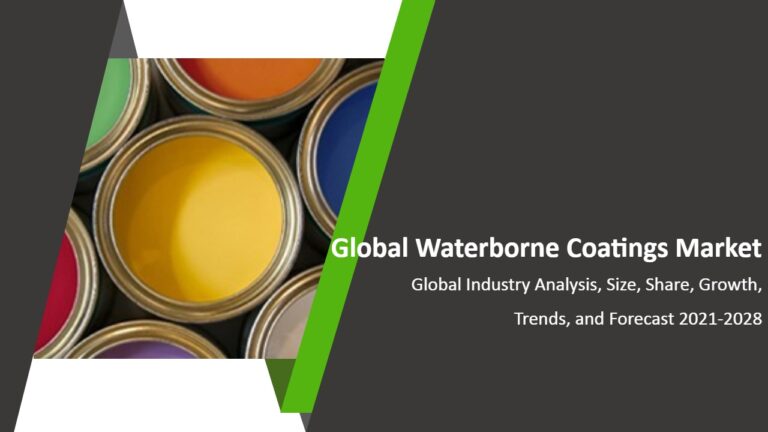The Global Waterborne Coatings Market was valued at around USD 77.5 billion in 2020 and is projected to reach around USD 111.07 billion by 2028, expanding at a CAGR of 4.6% during the forecast period, 2021-2028. The growth of the market is attributed to the rise in applications of waterborne coatings in the industry and residential sectors.
Waterborne coatings are used as surface coatings. The composition of the coatings may vary from each other. These types of coatings are made by mixing pigments and binders with water. Unlike paints, the waterborne coatings contain a minimum number of solvents. Generally, after the preservation of these coatings, they do not redissolve in water. The waterborne coatings market holds a key share in the coatings industry. The low environmental impact and the recovering economic conditions during the global pandemic have enabled the waterborne coatings market to gain a significant market share.
Waterborne Coatings Market Segment Insights:
Acrylic Segment dominates the market
Based on the types of resin, the global waterborne coatings market is bifurcated into acrylic, polyurethane, epoxy, alkyd, polyester, PTFE, PVDC, PVDF, and others. In 2019, the acrylic segment dominated the market, owing to its aesthetic properties and chemical characteristics. The acrylic coatings are mainly used in infrastructure and automotive due to their gloss retention and high-quality color properties. The acrylic segment is anticipated to dominate the market in the forecast period.
After the acrylic segment, the alkyd segment occupies the second position in this market. These waterborne coatings are mostly used in fillers, sealers, and caulks, owing to their flexibility.
Architectural Segment leads the market
In terms of applications, the global waterborne coatings market is divided into architectural, automotive, metal packaging, industrial wood, marine, coil, and others. Architectural waterborne coatings shield buildings from harsh climatic conditions such as strong wind, rain, and sunlight. Hence, the architecture industry is expected to hold a key market share in the forecast period. These coatings are also used in furniture and wall paintings. The growth of the construction industry is expected to have a positive effect on this market.
Asia Pacific holds a key market share
On the basis of regions, the global waterborne coatings market is segmented into Asia-Pacific, North America, Europe, Latin America, and Middle-East & Africa. The market in the Asia Pacific region is expected to grow at a robust CAGR in the coming years. Growing demand from construction, marine, and automotive industries from developing countries is expected to drive the market in this region. In the Asia Pacific region, it is anticipated that China will lead the demand, due to its high capacity of manufacturing and rising GDP. Rising demand from the automobile sector in Malaysia, Indonesia, Mexico, and Germany is anticipated to expand the market for waterborne coatings.
Market Trends, Drivers, Restraints, and Opportunities:
- Raw materials used in the manufacture of waterborne coatings mainly consist of pigments, additives, surfactants, and resins. The raw materials are used to manufacture different types of waterborne coatings, which are then used for varied applications such as industrial wood, marine, automotive, metal packing, and architectural.
- Standards such as Registration, Evaluation, Authorization and Restriction of Chemicals (REACH) by European Union (EU) and those by the US Environment Protection Agency (EPA) regularizes the waterborne coatings market.
- Stringent environmental standards and good economic conditions have contributed to the growth of this industry. Along with this, factors such as the surge in demand for automotive, infrastructure, and architecture have significantly fueled the growth of the market.
- Properties of waterborne coatings such as heat resistance, low flammability, and abrasion have attracted a large customer base.
- Waterborne coatings help in the reduction of air emissions. They do not require thinners or hardeners to be mixed with them. Moreover, the pot life of waterborne coatings is high, hence they can be stored in any sealed container for further use. These factors propel the market.
- Waterborne coatings have a low drying rate in high humidity areas. Additionally, it has a limited coating thickness of up to 1.2 inches. It requires corrosion-resistant equipment. Waterborne coatings are costlier in comparison with solvent-borne coatings. These factors tend to hinder market growth.
- Growth in marine, coil, packing, and wood industries has provided promising opportunities in this industry.
About Growth Market Reports:
GMR provides global enterprises as well as medium and small businesses with unmatched quality of “Market Research Reports” and “Industry Intelligence Solutions”. GMR has a targeted view to provide business insights and consulting to assist its clients to make strategic business decisions and achieve sustainable growth in their respective market domain. Our key analysis segments, though not restricted to the same, include market entry strategies, market size estimations, market trend analysis, market opportunity analysis, market threat analysis, market growth/fall forecasting, primary interviews, secondary research & consumer surveys.
Contact:
Growth Market Reports
Phone: +1 909 414 1393
Email: sales@growthmarketreports.com
Web: https://growthmarketreports.com
Follow Us: LinkedIn | Twitter
0






